
Polling expert Nate Silver says the latest surveys bring “bad results” for former President Donald Trump, showing his approval rating slipping as the country faces a partial government shutdown. According to Silver’s analysis, Trump’s current net approval rating is at –8.4 points, based on an average of almost all major polls, weighted by accuracy and methodology. That means about 43.9% of Americans approve of how he’s doing as president, while 52.3% disapprove.
Silver noted that Trump’s popularity has fallen across several key issues. On immigration, he’s at –4.7; on the economy, –15.3; on trade, –16; and on inflation, –27.7. These numbers show a noticeable drop since early June, when Trump still held a slightly positive score on immigration and smaller negatives elsewhere. Silver described the trend as “bad” for the president, saying that his economic approval is “substantially less popular than his first-term approach.”
However, the pollster also pointed out that Trump’s overall numbers are slightly better than they were eight years ago, when his approval rating stood at –16.7 during the same point in his first term. That suggests that while Trump remains unpopular with more than half of Americans, he’s managed to hold a stronger base of support this time around.
Trump’s approval appears to be divided sharply along income and age lines. A YouGov–Economist poll conducted earlier in October found that his approval among Americans earning under $50,000 a year dropped sharply—from a net –15 to –24 points. Meanwhile, wealthier voters with incomes above $100,000 saw an improvement in how they viewed him, going from –13 to –4. Another survey by HarrisX found that his support among older voters, aged 65 and up, fell by 13 points between July and September, leaving him at 43% approval and 56% disapproval among that key group.
These shifts come at a crucial political moment. The U.S. is in its 13th day of a partial government shutdown, with Senate Democrats refusing to pass a funding bill unless it includes an extension for health insurance subsidies. The political standoff, along with economic uncertainty, could shape how voters see Trump’s leadership heading into the November 2026 midterm elections. Democrats hope to win back at least one chamber of Congress, which would seriously limit Trump’s ability to push through his agenda during the final two years of his presidency.
Silver said that while Trump’s current approval isn’t disastrous, it’s clearly weak in areas that once were his strongest, particularly the economy and trade. He added that “these are bad results for Trump,” emphasizing that economic confidence—long seen as Trump’s advantage—has faded.
Looking ahead, analysts say any improvement in Trump’s numbers will depend on how voters perceive his handling of ongoing crises, including the government shutdown and international conflicts. One possible factor could be the recent release of Israeli hostages following a ceasefire deal in Gaza, though it remains unclear whether this event will affect public opinion.
As of now, Trump’s numbers suggest that the country remains deeply divided, with his support holding firm among loyalists but slipping among working-class voters and seniors—two groups that were key to his past election victories.




